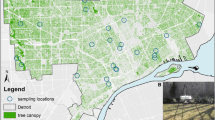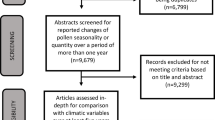Abstract
Measurement of atmospheric pollen concentrations is inexact, yet pollen concentrations are universally reported without estimate of accuracy. These imprecise values are nevertheless used for modelling, forecasting and public health decision-making. Estimation of the variability in reported pollen concentrations would help resolve associations between weather and pollen aerobiology as well as associations between pollen exposure and health. For any given daily atmospheric pollen level, a statistical variability would be expected in the set of possible measures. This variability is introduced and compounded by many factors including human error, classification error or instrument variability, as well as variability derived from strategies used to count and scale the airborne pollen sample. Here, we performed numeric simulations of pollen deposition and modelled the variability in contemporary pollen density estimates. Statistical distribution of the mean and variance of these simulated counts was compared with an existing pollen count dataset. Both simulations and actual pollen data showed that a significant range of atmospheric pollen concentrations could be inferred from the same daily pollen collection. The range of possible concentrations varied both with the atmospheric pollen density and with the portion of the daily pollen sample that is counted. Furthermore, pollen concentration data were shown to be non-normal and heteroscedastic, which has implications for a variety of tests (e.g. ANOVA), for regression analysis, and for pollen forecasting and forecast verification. These results reinforce the importance of counting as much of the collected pollen impaction surface as feasible to minimise the uncertainty in reported pollen levels. The outcomes of this study suggest that confidence intervals for daily pollen concentrations should be reported.




Similar content being viewed by others
References
Beggs, P., Davies, J., Milic, A., Haberle, S., Johnston, F., Jones, P., et al. (2018). Australian airborne pollen and spore monitoring network interim standard and protocols. Version 2, 14 September 2018 Queensland University of Technology and Macquarie University: Australian Society for Clinical Immunology and Allergy. https://www.allergy.org.au/hp/papers/australian-airborne-pollen-and-spore-monitoring-network-interim-standard-and-protocols. Accessed 10 Dec 2019.
Birnbaum, A. (1954). Statistical methods for Poisson processes and exponential populations. Journal of the American Statistical Association, 49(266), 254–266.
Buters, J. T. M., Antunes, C., Galveias, A., Bergmann, K. C., Thibaudon, M., Galán, C., et al. (2018). Pollen and spore monitoring in the world. Clinical and Translational Allergy, 8(1), 9–9. https://doi.org/10.1186/s13601-018-0197-8.
Carinanos, P., Emberlin, J., Galan, C., & Domingas-Vilches, E. (2000). Comparison of two pollen counting methods of slides from a hirst type volumetric trap. Aerobiologia, 16, 339–346.
Cheng, T. T. (1949). The normal approximation to the Poisson distribution and a proof of a conjecture of Ramanujan. Bulletin of the American Mathematical Society, 55(4), 396–401.
Comtois, P., Alcazar, P., & Daniel, N. (1999). Pollen counts statistics and its relevance to precision. Aerobiologia, 15(1), 19–28.
Cotos-Yañez, T. R., Rodríguez-Rajo, F. J., Pérez-González, A., Aira, M. J., & Jato, V. (2013). Quality control in aerobiology: comparison different slide reading methods. Aerobiologia, 29, 1–11. https://doi.org/10.1007/s10453-012-9263-1.
Davies, J. M., Erbas, B., Simunovic, M., Milic, A., Al Kouba, J., & Fagan, D. (2017). Literature review on thunderstorm asthma and implications for public health advice. In Commisioned by the Victorian Health Department of Health and Human Services (Ed.). https://www2.health.vic.gov.au/about/publications/researchandreports/thunderstorm-asthma-literature-review-may-2107. Accessed 10 Dec 2019.
de Morton, J., Bye, J., Pezza, A., & Newbigin, E. (2011). On the causes of variability in amounts of airborne grass pollen in Melbourne, Australia. International Journal of Biometeorology, 55(4), 613–622. https://doi.org/10.1007/s00484-010-0361-x.
Emmerson, K. M., Silver, J. D., Newbigin, E., Lampugnani, E. R., Suphioglu, C., Wain, A., et al. (2019). Development and evaluation of pollen source methodologies for the Victorian Grass Pollen Emissions Module VGPEM1.0. Geoscientific Model Development. https://doi.org/10.5194/gmd-12-2195-2019.
European Commitee for Standardization. (2019). European Standard EN 16868 Ambient air—Sampling and analysis of airborne pollen grains and fungal spores for networks related to allergy—Volumetric Hirst method
Galán, C., Smith, M., Thibaudon, M., Frenguelli, G., Oteros, J., Gehrig, R., et al. (2014). Pollen monitoring: Minimum requirements and reproducibility of analysis. Aerobiologia, 30(4), 385–395. https://doi.org/10.1007/s10453-014-9335-5.
Geller-Bernstein, C., & Portnoy, J. M. (2019). The clinical utility of pollen counts. Clinical Reviews in Allergy and Immunology, 57(3), 340–349. https://doi.org/10.1007/s12016-018-8698-8.
Gottardini, E., Cristofolini, F., Cristofori, A., Vannini, A., & Ferretti, M. (2009). Sampling bias and sampling errors in pollen counting in aerobiological monitoring in Italy. Journal of Environmental Monitoring, 11(4), 751–755.
Green, B. J., Dettmann, M. E., Rutherford, S., & Simpson, R. W. (2002). Airborne pollen of Brisbane, Australia: A five-year record, 1994–1999. Grana, 41(4), 242–250. https://doi.org/10.1080/001731302321012031.
Irdi, G. A., Jones, J. R., & White, C. M. (2002). Pollen and fungal spore sampling and analysis: Statistical evaluations. Grana, 41(1), 44–47. https://doi.org/10.1080/00173130260045495.
Käpylä, M., & Penttinen, A. (1981). An evaluation of the microscopical counting methods of the tape in Hirst–Burkard pollen and spore trap. Grana, 20(2), 131–141.
Kubik-Komar, A., Piotrowska-Weryszko, K., Weryszko-Chmielewska, E., Kuna-Broniowska, I., Chłopek, K., Myszkowska, D., et al. (2019). A study on the spatial and temporal variability in airborne Betula pollen concentration in five cities in Poland using multivariate analyses. Science of the Total Environment, 660, 10070–11078. https://doi.org/10.1016/j.scitotenv.2019.01.098.
Lindstrom, S. J., Silver, J. D., Sutherland, M. F., Treloar, A. B., Newbigin, E., McDonald, C. F., et al. (2017). Thunderstorm asthma outbreak of November 2016: A natural disaster requiring planning. Medical Journal of Australia, 207(6), 235–237.
Milic, A., Addison-Smith, B., Jones, P. J., Beggs, P. J., Erbas, B., & Davies, J. M. (2019). Quality control of pollen identification and quantification exercise for the AusPollen Aerobiology Collaboration Network: A pilot study. Aerobiologia. https://doi.org/10.1007/s10453-019-09580-4.
Patel, T. Y., Buttner, M., Rivas, D., Cross, C., Bazylinski, D. A., & Seggev, J. (2018). Variation in airborne pollen concentrations among five monitoring locations in a desert urban environment. Environmental Monitoring and Assessment, 190(7), 424. https://doi.org/10.1007/s10661-018-6738-8.
Prank, M., Chapman, D. S., Bullock, J. M., Belmonte, J., Berger, U., Dahl, A., et al. (2013). An operational model for forecasting ragweed pollen release and dispersion in Europe. Agricultural and Forest Meteorology, 182–185, 43–53. https://doi.org/10.1016/j.agrformet.2013.08.003.
Thien, F., Beggs, P. J., Csutoros, D., Darvall, J., Hew, M., Davies, J. M., et al. (2018). The Melbourne epidemic thunderstorm asthma event 2016: An investigation of environmental triggers, effect on health services, and patient risk factors. The Lancet. Planetary Health, 2(6), e255–e263. https://doi.org/10.1016/S2542-5196(18)30120-7.
Tormo Molina, R., Rodríguez, A. M., & Palacios, I. S. (1996). Sampling in aerobiology. Differences between traverses along the length of the slide in Hirst sporetraps. Aerobiologia, 12, 161–166.
Ulm, K. (1990). Simple method to calculate the confidence interval of a standardized mortality ratio (SMR). American Journal of Epidemiology, 131(2), 373–375.
Victorian Department of Health and Human Services. (2018). Epidemic thunderstorm asthma forecast. Retrieved August 27, 2019, from https://www2.health.vic.gov.au/public-health/environmental-health/climate-weather-and-public-health/thunderstorm-asthma/forecasting
Ziello, C., Sparks, T. H., Estrella, N., Belmonte, J., Bergmann, K. C., Bucher, E., et al. (2012). Changes to airborne pollen counts across Europe. [Research Support, Non-U.S. Gov't]. PLoS ONE, 7(4), e34076. https://doi.org/10.1371/journal.pone.0034076.
Ziska, L. H., Makra, L., Harry, S. K., Bruffaerts, N., Hendrickx, M., Coates, F., et al. (2019). Temperature-related changes in airborne allergenic pollen abundance and seasonality across the northern hemisphere: A retrospective data analysis. Lancet Planet Health, 3(3), e124–e131. https://doi.org/10.1016/S2542-5196(19)30015-4.
Acknowledgements
We acknowledge Mrs Victoria Timbrell, Mr Marko Simunovic, Ms Divya Dwarakanath and Dr Andelija Milic (Queensland University of Technology) for providing access to QUT pollen counting data and Ms Rachel Yang and Ms Serine Lee for entry of daily hand recorded transect data. We acknowledge grant support from the Australian National Health and Medical Research Council AusPollen Partnership (GNT1116107) and the Australian Research Council Discovery Project (170101630). We thank the Queensland Department of Environment and Science of access to the Rocklea Air Quality Monitoring site and the team for support.
Author information
Authors and Affiliations
Corresponding author
Rights and permissions
About this article
Cite this article
Addison-Smith, B., Wraith, D. & Davies, J.M. Standardising pollen monitoring: quantifying confidence intervals for measurements of airborne pollen concentration. Aerobiologia 36, 605–615 (2020). https://doi.org/10.1007/s10453-020-09656-6
Received:
Accepted:
Published:
Issue Date:
DOI: https://doi.org/10.1007/s10453-020-09656-6




